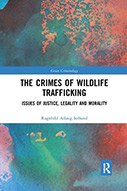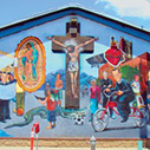The Crimes Of Wildlife Trafficking: Issues Of Justice, Legality And Morality

Author: Ragnhild Aslaug Sollund
Publisher: London; New York: Routledge, 2019. 302p.
Reviewer: Rob White | November 2020
The timing of a review sometimes has a bearing on its content. For example, this important and thought-provoking book resonates quite differently now, in the midst of Covid-19, then pre-Covid. Indeed, the urgency that underpins Ragnhild Sollund’s arguments about the wildlife trade has only accelerated in the past few months in the light of the apparent link between the coronavirus and the ‘wet markets’ of Wuhan. Wildlife is not only in the news but in its own perverse way it now dominates our daily lives.
In present circumstances, it is suitable therefore to take the end of Sollund’s book as our beginning. In its conclusion, Ragnhild Sollund asserts the importance of adopting a compassionate conservation based upon the principle of ‘do no harm’. She argues that this applies to all non-human animals and that such ethics transcend the legal/illegal divide. Specifically, she says that ‘our obligations to care apply just as much for those animals who are not under our care, those free-born animals who we either kill or put into traffick, since also for them to be killed is counter to their interests, and putting them into traffick, we set them forcefully under our dominion in situations in which they are bound to suffer’ (p.235). At the core of this book is thus a powerful moral argument about the status of non-human animals generally, and the role of humans in harming other sentient beings.
But this is only one, albeit the most important, theme or topic of the book. The bulk of the book largely consists of empirical analyses of animals and animal products trafficked to, within and from Norway, and within Colombia. Detailed consideration is provided of what is trafficked, by whom, and for what purposes. Discussions consider the gendered nature of trafficking of animals, including specific crimes of masculinity (such as trophy hunting). The discussions also reposition animals as ‘victims’ who are subjected to systematic abuses in both countries. In other words, the focus is (and, as Sollund asserts, ought to be) on the harm that is committed against the animal victim.
Drawing upon documentation (for example, police files), court records (penal cases) and interviews (including with perpetrators), the book reveals the extent of the trade, the key players, the complexities involved in enforcement of laws against wildlife trafficking, and the substantial limitations of regulation, enforcement and prosecution on the part of authorities in Norway and Colombia. Key issues in relation to intervention and operations included resources (and lack thereof), priorities (such as other types of crimes or commodities), compartmentalisation of responsibilities (division into administrative silos) and the relative leniency of punishment (for example, usually a fine).
The book provides rich investigation into the world of wildlife trafficking and responses to this by customs officials, courts, police, environment agencies, non-government organisations and wildlife rehabilitation centres. Each country is examined closely in regards to official responsibilities, laws and policies, and intervention practices. Much of this is framed by CITES – the Convention on International Trade in Endangered Species of Wild Fauna and Flora – itself considered problematic insofar as, in the eyes of the author, it allows for and legitimates harms to non-human animals. Yet, as pointed out in the book, much animal trafficking takes place within nation-states rather than across international borders, and so are often more of a national than international problem.
Throughout the discussion, the issues and findings are interpreted through the philosophical lens of ecofeminism and care ethics, which is explained by the author in the preliminary chapters. This adds a tremendously powerful and indeed, challenging, ethical dimension to the book as a whole. This is not about legality and criminality as conventionally portrayed. Nor is it about doing the right thing because it fits within a paternalistic anthropocentric (or human-centred) framework, such as supporting ‘sustainable’ and ‘legal’ trade in wildlife.
Rather, Ragnhild Sollund provides a critique that involves condemnation of the core premise – namely, that any trade in non-human animals can be justified. In advancing this viewpoint, Sollund invites the reader to see and empathise with the ‘other’, meaning in this case non-human sentient animals. She says that it is vital to see who the animal is, to appreciate their experience as if it were our own. To deny animal suffering is to engage in the negation of empathy. This is a profoundly moral question – and ethical imperative. She observes that ‘[b]y acknowledging the direct connection and relatedness that are produced through empathy, the only consequence if we are to produce a just world for non-human species is to stop regarding wild animals (or other animals) as exploitable resources that can be used and/or killed as long as their species survives’ (p. 38). Action thus should follow from these core moral considerations.
At a concrete level, the analyses provided in this book inevitably lead to one conclusion – that is, to ban the trade in animals altogether. The choice is starkly put by analogy with human trafficking: ‘[j]ust like one would not argue for regulating human trafficking and enslavement, one cannot argue for the regulation of wildlife trade. Whether trafficking in humans or animals, it is an abominable crime’ (p.205). In this respect, Sollund’s recommendation is echoed in current calls for the banning of the wildlife trade because of the threats of zoonotic pandemic stemming from human capture, caging and consumption of wild animals. Yet, the solution is, of course, much more complicated than a simple ban implies.
As the book points out, there is great diversity in motive and social condition that unpins wildlife use and trade. A number of aspects of the human-wildlife interaction are deeply embedded culturally, as well as reflecting the (human) need for sustenance and income. A flat-out ban on wildlife trading would immediately create hardship for many people struggling to keep body and soul together. It would not only push the trade underground but would have socially unequal consequences. While the book canvasses several strategic options, such as more extensive education and information about the issues and enhanced enforcement and sanctioning processes, more discussion is needed about transitions, local contexts and meeting of social needs. Perceptions of top-down imposition tend to generate push-back from below and this, too, requires its own policy and practical sensitivities.
More generally, the positioning of non-human animals as free-born sovereigns (as opposed to property or common good), somehow seems to simultaneously position them outside of the animal-human relation. To put it differently, there appears to be an absolutist element about the notion of animals as intrinsic rights-holders that glosses over the complications of real-world human decision-making in regards non-human animals. For example, there are material realities in which so-called feral or alien animal species threaten the wellbeing of other species (including animals) because of weight of numbers and/or carrying of transmittable diseases. Likewise, local ecological systems and biodiverse areas may come under pressure due to non-human animal proliferation and/or ecocidal destruction of habitat (eating of biologically distinctive plants). What is the moral obligation of humans in relation to these issues? None of these issues is easily solved or answered; certainly, the ethical matters raised by Sollund further complicate an already messy moral conundrum.
There are also larger issues relating to the position of both humans and non-human animals within Nature and, as such, the dual reality that this can, and indeed (arguably) must, involve both intrinsic value and instrumental use. How this occurs is of course of profound philosophical and moral importance. For instance, the use of animals for food and clothing does not necessarily have to occur within a relationship of exploitation per se. Indigenous communities around the world have for millennium had spiritually grounded respect and value for the creatures around them, including those which they harvest and utilise to meet their human needs. There is a context, historical pattern and interactive dimension here which precludes separation of human from non-human animal, as each in its own way is consequential for the other.
The brilliance of The Crimes of Wildlife Trafficking lies in the provocative and stimulating manner in which it raises a host of really difficult moral, theoretical and practical questions. The failures of current systems of environmental regulation and animal protection are laid bare, as are the multitude of factors which generate engagement in the pernicious, harmful victimisation of non-human sentient animals. The book’s strong moral thread, emphasising care and empathy for the animal ‘other’, means that it cannot possibly be read as a neutral, technical exercise of academic evaluation. Whether or not one agrees with its basic propositions, the reader cannot but pause to reflect on the fundamental questions of life, love and respect that it raises. For how we treat animals – whether in a legal framework or not – is essentially a statement about the human condition. The book is ostensibly about the wildlife trade. But it is much more than this, and we are better served because of it.
Rob White, Distinguished Professor of Criminology, University of Tasmania, Australia


